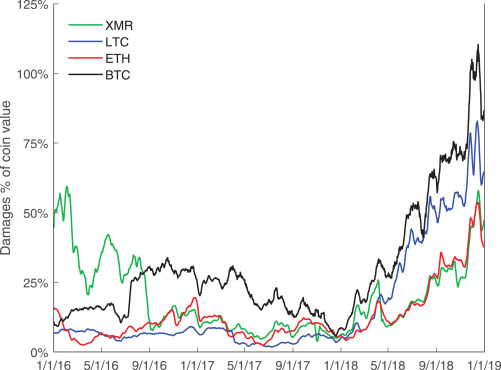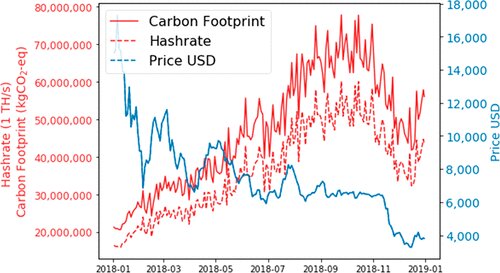Cryptocurrency mining, the process by which transactions are validated and added to a blockchain, has garnered attention not only for its role in decentralized networks but also for its substantial environmental footprint. As digital currencies like Bitcoin and Ethereum have surged in popularity, the energy-intensive nature of mining operations has raised concerns regarding their environmental impact. The quest to secure and verify transactions through computationally complex algorithms demands significant computational power, leading to a substantial consumption of electricity, primarily sourced from non-renewable energy sources. This growing energy demand of mining activities has sparked discussions and debates around the environmental consequences of sustaining cryptocurrencies.
The exponential growth of cryptocurrency markets, coupled with the soaring value of digital assets, has amplified the energy requirements for mining. The mining process, notably based on Proof of Work (PoW) mechanisms, relies on powerful hardware and energy-intensive computations, contributing to the substantial carbon footprint associated with these operations. Beyond the environmental implications, concerns have emerged about the local impacts of mining activities on communities and ecosystems, ranging from increased demand for electricity in specific regions to physical disturbances in areas hosting mining facilities. As cryptocurrencies continue to gain traction, examining and mitigating the environmental consequences of mining operations have become imperative to ensure a more sustainable future for both the digital economy and the planet.

Understanding the intricate relationship between cryptocurrency mining and its environmental repercussions is crucial in evaluating the overall sustainability of these digital assets. The exploration of how mining practices align with global efforts toward sustainability and the development of strategies to mitigate their environmental impact stands as a pivotal aspect in the ongoing discourse surrounding the future trajectory of cryptocurrencies within the broader context of environmental stewardship.
Energy Consumption in Cryptocurrency Mining
Cryptocurrency mining stands notorious for its energy-intensive operations, primarily propelled by the Proof of Work (PoW) consensus mechanism utilized by numerous blockchain networks. This mining process involves miners using computational power to solve intricate algorithms, validating transactions, and securing the network. The energy consumption of mining activities is significant, particularly in Bitcoin mining, due to its robust and resource-intensive network architecture.
This energy demand continues to escalate with the expanding network and the burgeoning complexity of cryptographic puzzles. Notably, various cryptocurrencies exhibit varying degrees of energy consumption; newer cryptocurrencies are exploring alternatives like Proof of Stake (PoS) to reduce their energy footprint. However, the overarching concern remains the exponential surge in energy consumption and its potential long-term environmental ramifications.
Environmental Impacts and Challenges
Cryptocurrency mining poses multifaceted environmental challenges, notably through its substantial carbon footprint. The energy-intensive nature of mining, often reliant on non-renewable energy sources, contributes significantly to carbon emissions. Estimates suggest that Bitcoin mining alone yields a substantial carbon footprint comparable to certain small nations.

Beyond carbon emissions, mining operations can inflict direct and indirect impacts on local ecosystems and communities. The concentrated energy demands of mining facilities strain regional power infrastructures and may lead to unequal access to electricity for nearby communities. Moreover, the physical presence of mining operations might disrupt landscapes, potentially causing habitat destruction and endangering biodiversity. Addressing these challenges involves adopting sustainable mining practices, transitioning towards renewable energy sources, and devising more environmentally friendly consensus mechanisms to mitigate the environmental impact while fostering the cryptocurrency industry’s sustainable growth.
Mitigation Strategies and Innovations
The adoption of sustainable practices in cryptocurrency mining involves a concerted effort to transition towards greener energy sources and renewable energy. Mining entities are increasingly exploring renewable energy options like hydroelectric, solar, and wind power to power their operations. Initiatives are being taken globally to establish mining facilities in regions abundant in renewable energy resources, reducing the reliance on fossil fuels and curbing the environmental impact of mining. Moreover, technological innovations play a pivotal role in mitigating the environmental footprint of mining. Developments in mining hardware and software aim to enhance energy efficiency, optimizing computational processes to reduce energy consumption without compromising network security.
In response to growing environmental concerns, the cryptocurrency community is witnessing grassroots initiatives and movements advocating for eco-friendly mining practices. Various organizations and communities within the crypto sphere are actively engaging in discussions, research, and initiatives focused on sustainable mining. This includes promoting awareness about the environmental impact of mining, incentivizing the adoption of greener practices, and fostering collaborations to explore innovative solutions. These efforts are geared towards fostering a more sustainable approach to mining while maintaining the integrity and decentralization of blockchain networks.

Regulatory and Industry Response
Governmental bodies are increasingly recognizing the environmental implications of cryptocurrency mining and are formulating regulations and policies to address these concerns. Some regions have introduced regulations mandating the use of renewable energy or imposing carbon taxes on mining operations to incentivize a shift towards cleaner energy sources.
Simultaneously, industry-driven initiatives aim to promote sustainable mining practices. Mining companies and industry stakeholders are collaborating to create best practices, frameworks, and guidelines to encourage environmentally responsible mining. Collaborative efforts among stakeholders, including governments, industry players, environmental groups, and academia, aim to foster dialogues and implement measures that balance the growth of the cryptocurrency industry with environmental sustainability.
Conclusion
The environmental impact of cryptocurrency mining stands as a critical focal point amidst the digital currency revolution. As the industry continues to expand, the spotlight on its energy-intensive nature and associated environmental implications grows ever brighter. The substantial energy demands and resultant carbon emissions from mining operations have sparked global concerns, prompting a collective search for sustainable solutions. While the decentralized nature of cryptocurrencies is celebrated, the ecological footprint of mining remains a significant challenge that necessitates immediate attention and action.

Efforts toward mitigating the environmental impact of cryptocurrency mining are underway, with a growing emphasis on adopting greener energy sources and fostering technological innovations. The shift towards renewable energy and the exploration of more energy-efficient mining protocols like Proof of Stake (PoS) or other consensus mechanisms signify a proactive step towards reducing the carbon footprint of blockchain networks. Additionally, regulatory measures, industry-driven initiatives, and collaborative efforts within the cryptocurrency community showcase a collective intent to address these challenges. The engagement of diverse stakeholders, from governments to industry players and advocacy groups, is vital in charting a sustainable path for the future of cryptocurrency mining.
Balancing the growth and innovation within the cryptocurrency space with environmental responsibility remains an ongoing endeavor. The evolution of mining practices towards sustainability is imperative for the long-term viability of the industry. Collaborative endeavors, technological advancements, regulatory frameworks, and a shared commitment to eco-friendly mining practices are crucial in paving the way for a more sustainable future, ensuring that the transformative potential of cryptocurrencies aligns harmoniously with environmental stewardship.





Add comment